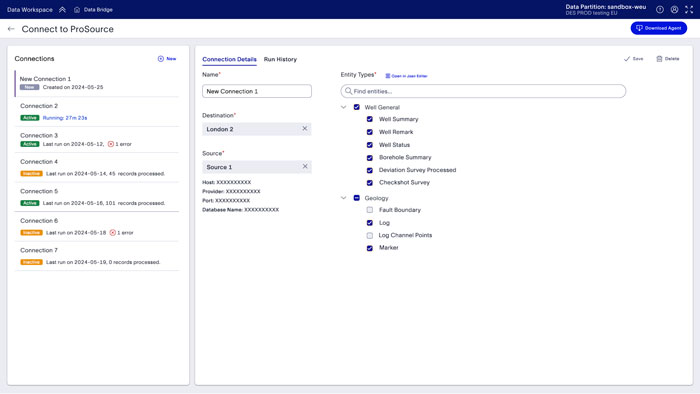Onboarding to OSDU
How SLB connectors help to accelerate the OSDU adoption journey
The promises of digital transformation and cloud adoption are not new in the energy sector. However, many workflows are still largely on-premises and companies are missing out on the step change in efficiency gains heralded by cloud-based automation, AI and vast compute and processing capability. Among the reasons for this are the complexity of transition and effort required to migrate data and workflows to the cloud. This creates a perception of deferred time-to-value when investing in digital technology and the requirement of multi-year transformation programs. Put simply, transitioning to cloud technologies such as the Open Group’s OSDU® Technical Standard is considered too disruptive, too costly, and too time consuming. What is missing is the ability to bridge the gap between traditional on-premises technology and the cloud in a way that promotes faster value realization.
The Lumi™ data and AI platform from SLB provides three levels of integration that enable users to realize value early, and incrementally, along the adoption journey of the Technical Standard. The first level is to connect and discover, where data from on-premise sources is scanned and indexed. The second is assess and enrich, by creating new insights into the data. The third is to standardize and consume, using the Technical Standard to make the data available and interoperable in a growing number of domain applications.

Using an E&P data bridge, the Lumi platform seamlessly connects on-premises data to the cloud. It does this automatically, it is achieved by a connector framework comprising of data agents, that can be deployed in the on-premises environment and connect to the data sources. The connector framework supports common E&P data sources, including the ProSource™ E&P data management and delivery system.
The agents scan and index data sources, making the data searchable, discoverable, and accessible. Creating a single pane of glass for data discovery not only increases the visibility and availability of data, it also allows to connect dashboards and data science tools, enabling users to generate new insights into the data. In addition, rule-based data quality engines enable users to easily assess and improve the overall data quality and completeness.
Consumption of data in domain applications is enabled by transforming the data to the OSDU data model, a common standard for interoperability between connected applications. The E&P data bridge provides transformations that standardize data to the OSDU data model and enable consumption through the open data contracts, APIs, and domain data management services (DDMS) provided by OSDU. For common E&P data sources, the standardizations are pre-configured, making the data onboarding process fast and effortless.
So how does the Lumi platform help to accelerate the OSDU adoption journey? The connector framework dramatically reduces the time and effort spent on connecting to on-premises data sources and bringing the data into a common environment. This common environment serves as a single access point for users to discover data and for systems such as dashboards and GenAI to connect to the data. As a result, data managers and data scientists spend less time looking for relevant data. The ability to automatically assess the data quality means that irrelevant, low quality, and duplicate data can be filtered, so that only validated, trusted, and complete data is used as input to data-driven processes and decisions. The ability to transform data, together with a suite of pre-build transformations from well-known E&P data sources to OSDU, enables the creation of standardized data ready for consumption in domain workflows. The data pipelines that enable these transformations are fully automated and rules-based, meaning the data delivery process is scalable and repeatable.
The incremental levels of integration offered by the Lumi platform allow users to gradually onboard to cloud-based workflows, while keeping their source of truth on-premises and without disrupting existing integrations and business processes. The ability to enable data centric workflows in the cloud allows users to harness modern technologies and capabilities that are not readily available on-premises, from optical character recognition to natural language processing and generative AI.
The framework seamlessly extends to data migration and transformation, which are prerequisite to enabling OSDU-based consumption workflows. This gives rise to a hybrid scenario, where on-premises and cloud workflows co-exist, giving customers the choice of which workflows to transition to the cloud and when, if ever, to adopt a fully cloud-based data environment.

